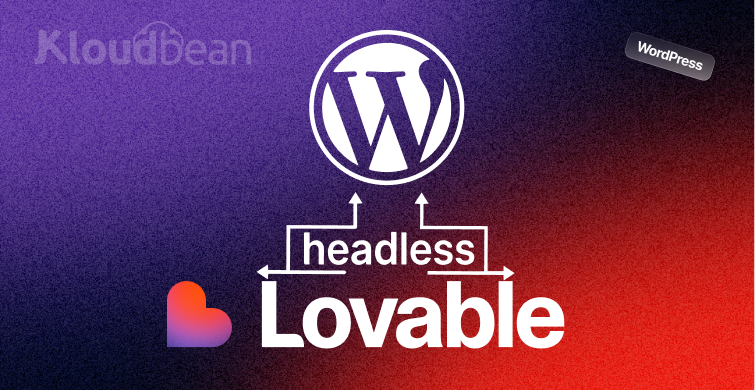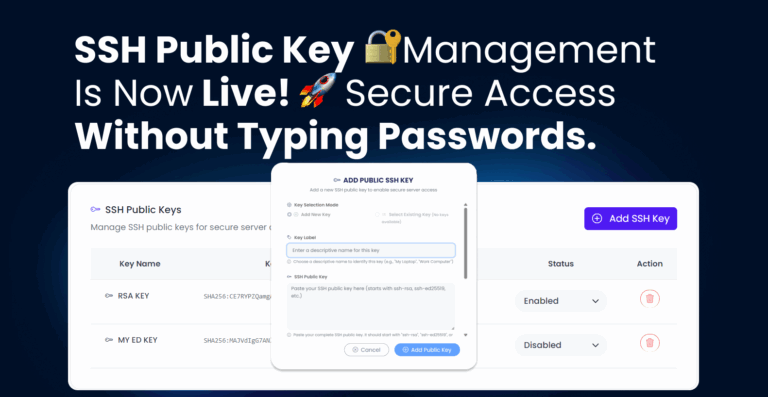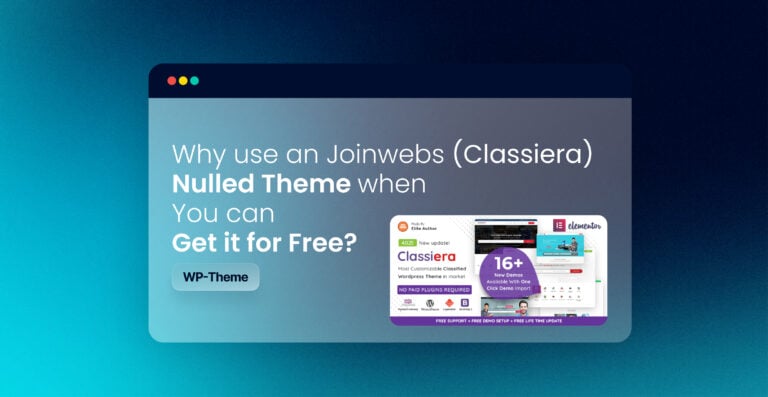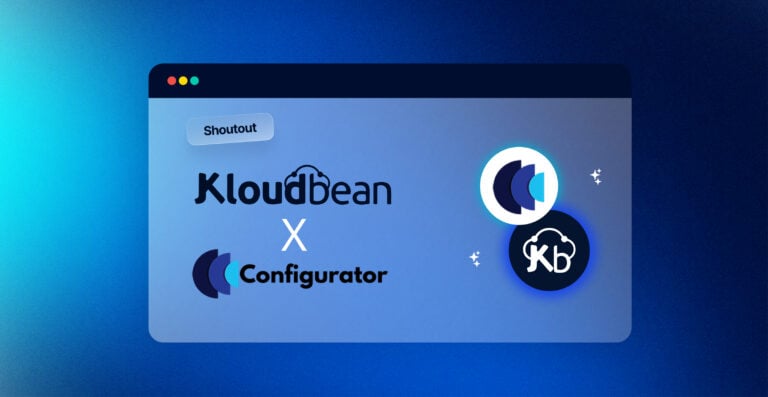I remember my first WordPress website back in 2010. Installation took hours. Choosing a theme meant compromising on design. Custom features required expensive developers. Fast forward to today, and everything has changed.
The web development world experienced a revolution I didn’t see coming. Traditional WordPress still works, but it feels like driving a horse and buggy on a highway. There’s a better way now – headless WordPress with AI-generated frontends.
This guide will show you exactly how I transformed my approach to building websites. You’ll discover why headless WordPress matters, how AI tools like Lovable make it accessible to everyone, and why platforms like Kloudbean eliminate the traditional barriers that kept most people away from this technology.
What Headless WordPress Actually Means
Let me break this down simply. Traditional WordPress websites work like a restaurant where the kitchen and dining room are permanently connected. Everything happens in one space. The chef (WordPress) prepares the meal and serves it directly to customers using the same system.
Headless WordPress is like separating the kitchen from the dining room. WordPress becomes your kitchen – preparing all the content, managing ingredients, handling the complex stuff behind the scenes. But your customers eat in a completely separate, beautifully designed restaurant built with modern tools.
The “head” in headless refers to the frontend – what visitors see. We remove that traditional frontend and replace it with something faster, more flexible, and infinitely customizable.
Here’s what happens when someone visits your headless WordPress site:
- Your beautiful frontend (built with React, Vue.js, or other modern frameworks) loads instantly
- When it needs content, it asks WordPress through APIs
- WordPress sends the content data
- Your frontend displays it in whatever gorgeous format you’ve designed
The visitor never sees WordPress. They experience your custom-designed interface while you manage everything through the familiar WordPress admin panel.
Why Headless WordPress Matters More Than Ever
Traditional WordPress websites face serious problems in 2024. Users expect websites to load in under two seconds. Google penalizes slow sites in search rankings. Mobile users abandon sites that don’t perform well.
I’ve seen countless WordPress sites struggle with these issues:
Performance Problems: Traditional WordPress loads everything at once. Your theme, plugins, widgets – all rendering server-side for every page request. This creates bloated, slow-loading experiences.
Design Limitations: You’re stuck with theme constraints. Want a unique layout? You need custom development or complicated page builders that make sites even slower.
Security Vulnerabilities: The entire WordPress installation is exposed to the internet. Hackers have multiple attack vectors through themes, plugins, and core files.
Mobile Experience: Most WordPress themes claim to be “mobile responsive,” but they’re really just desktop sites that squeeze onto smaller screens.
Headless WordPress solves every one of these problems fundamentally.
Lightning Performance: Your frontend loads as static files. No server processing for each page view. Content delivers through global CDNs instantly.
Unlimited Design Freedom: No theme restrictions. Create any design imaginable using modern frontend frameworks and tools.
Enhanced Security: WordPress stays hidden behind APIs. Attackers can’t access your admin panel directly. Much smaller attack surface.
Mobile-First Experience: Build native mobile experiences or progressive web apps that feel like smartphone applications.
The Traditional Headless WordPress Problem
Before platforms like Kloudbean and AI tools like Lovable, headless WordPress was exclusively for technical experts. The setup required:
Multiple Hosting Services: WordPress hosting, frontend hosting, database management, SSL certificates, CDN services. Each with different interfaces, billing cycles, and support teams.
Deep Technical Knowledge: Understanding React, Vue.js, Node.js, API integration, authentication systems, deployment pipelines, and modern development workflows.
Significant Development Time: Building custom frontends took months. Every component needed hand-coding. Integration required complex API management.
Ongoing Maintenance Complexity: Updates to WordPress might break frontend connections. Frontend changes could affect content management. Debugging required expertise in multiple systems.
High Costs: Professional developers charged premium rates for headless projects. Multiple hosting services added up quickly. Custom development was expensive and time-consuming.
These barriers kept headless WordPress limited to large companies with dedicated development teams and substantial budgets.
How Vibecode Platforms Changed Everything
The emergence of AI-powered development platforms revolutionized headless WordPress accessibility. Tools like Lovable, Cursor, and v0.dev can generate complete, professional frontends from simple descriptions.
I tested this personally. Instead of spending weeks coding a blog layout, I told Lovable: “Create a modern blog homepage with hero section, recent posts grid, newsletter signup, and dark mode toggle.” Within minutes, I had production-ready React code.
These platforms understand complex requirements. They generate responsive designs, implement modern best practices, handle error states, and create accessible interfaces automatically. The code quality often exceeds what junior developers produce manually.
But the real breakthrough came when these AI tools learned to integrate with WordPress APIs. Now you can describe not just design requirements, but complete functionality: “Connect this blog to my WordPress backend, display posts with featured images, add search functionality, and implement real-time updates.”
The AI handles all technical integration automatically.
Why Kloudbean Makes This Setup Actually Work
Here’s where most people still struggle. You have WordPress running somewhere. You have AI-generated frontend code. Now what?
Traditional hosting solutions force you into technical complexity:
- Upload WordPress to one server
- Deploy frontend code to another service
- Configure databases separately
- Manage SSL certificates manually
- Set up CDN services
- Handle integration between systems
Shared hosting companies using cPanel can’t handle this workflow without forcing you into command-line interfaces, server configuration files, and hundreds of technical commands.
Kloudbean approached this problem differently. Instead of making you manage multiple services, they created a unified platform where everything works together seamlessly.
Single Dashboard Control: Install WordPress with one click. Deploy Vue.js applications just as easily. Manage databases, SSL certificates, and monitoring from the same interface.
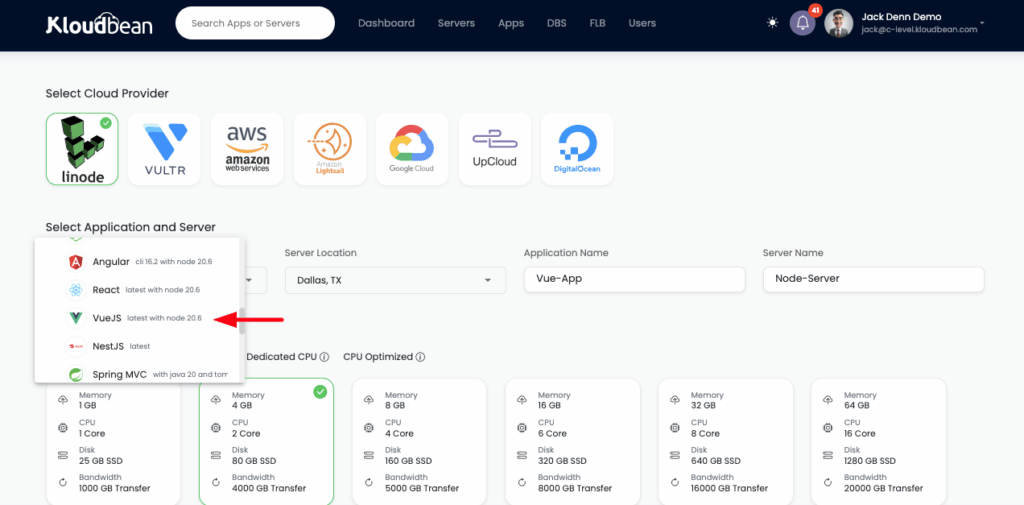
No Technical Complexity: Click “Add Application,” select “WordPress” from the dropdown. Installation completes in under 40 seconds. Want a Vue.js frontend? Same process – click, select, deploy.
Cost Effectiveness: One server runs multiple applications. One bill covers everything. No separate charges for SSL, CDN, or database services.

Built-in Integration: WordPress and frontend applications run on the same infrastructure. No complex networking or API configuration required.
Expert Support: When you need help, support understands your entire stack. No more getting passed between different technical teams.
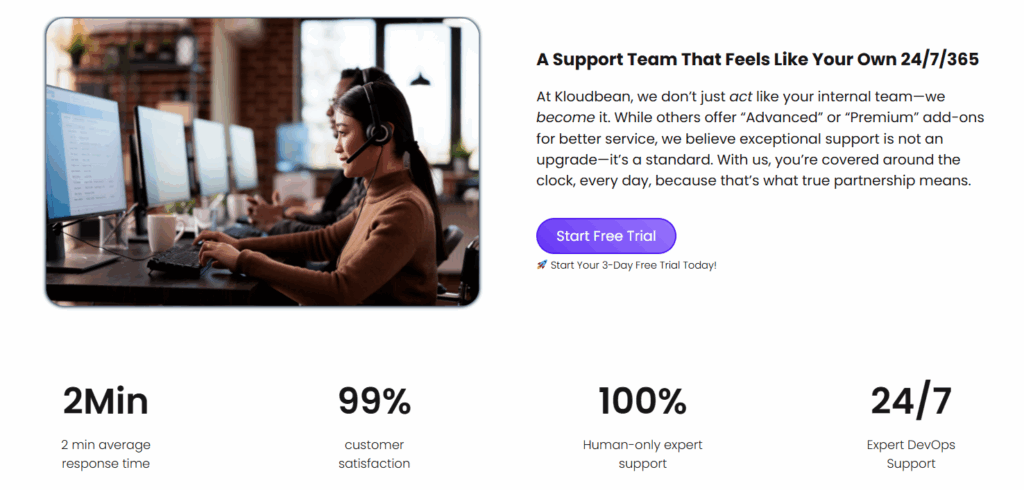
I’ve run five different headless WordPress sites on a single Kloudbean server. Total monthly cost is less than what I used to pay for one traditional WordPress hosting account.
Complete Step-by-Step Implementation
Let me walk you through building your first headless WordPress site exactly as I do it.
Setting Up Your Foundation on Kloudbean
Start by creating your hosting environment. Kloudbean’s interface makes this straightforward for anyone.
Visit kloudbean.com and create your account. Choose a server plan based on your expected traffic and storage needs. Select your preferred cloud provider and datacenter location closest to your audience for optimal performance.
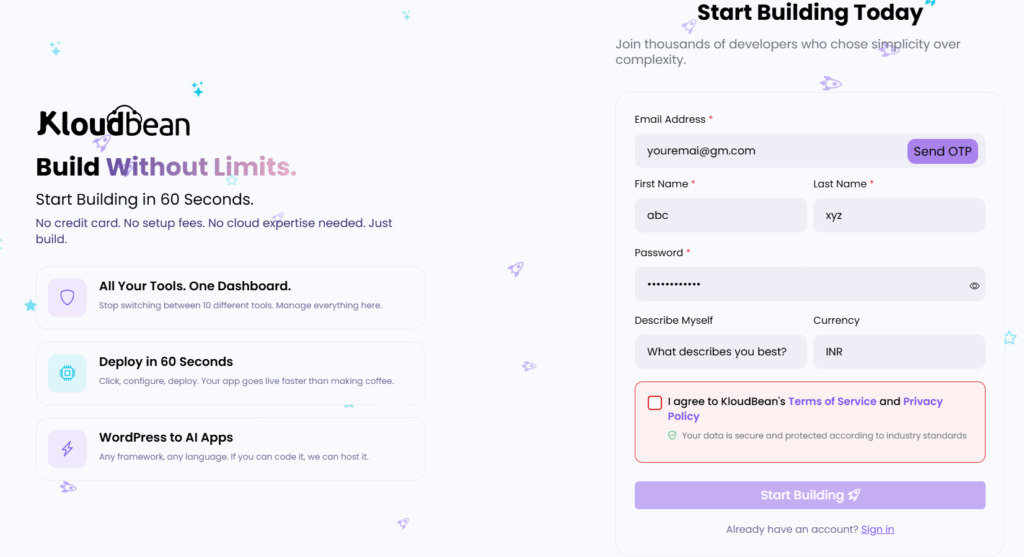
Once your account activates, you’ll see the main dashboard. This single interface controls everything – no jumping between different hosting panels or management systems.
Installing WordPress in Under a Minute
From your Kloudbean dashboard, click “Add Application.” You’ll see a dropdown menu with various application types. Select “WordPress.”
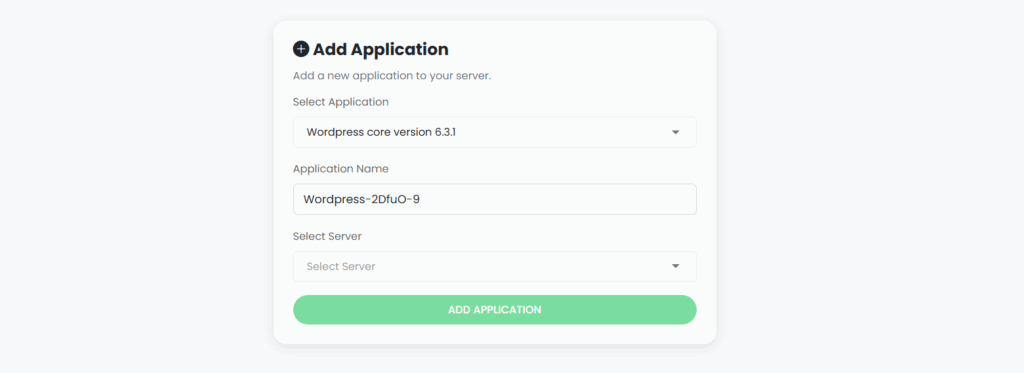
That’s it. Kloudbean handles:
- Database creation and configuration
- WordPress file installation
- SSL certificate generation
- Security hardening
- Performance optimization
- Backup configuration
The entire process completes in 30-40 seconds. You’ll receive WordPress admin credentials and can immediately start using your familiar WordPress interface.
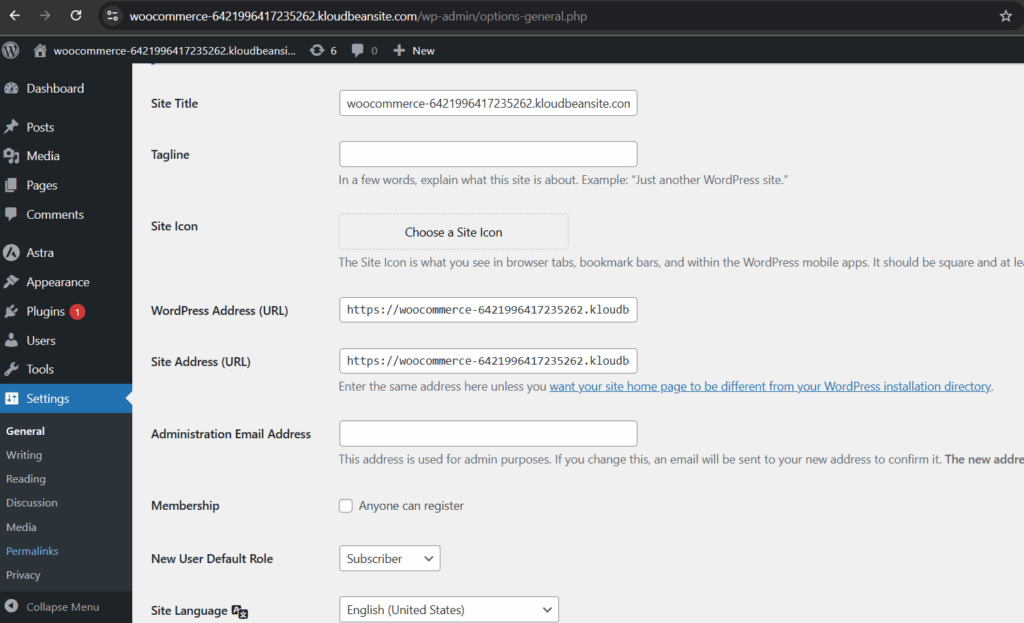
Configure your WordPress permalink structure by going to Settings > Permalinks and selecting “Post name.” This creates clean URLs that integrate perfectly with modern frontend frameworks.
Creating Your Frontend Environment
With WordPress running, add your frontend application to the same server. Click “Add Application” again and select “Vue.js” since Lovable generates Vue.js code.

Your Vue.js environment deploys automatically. You now have both WordPress and a modern frontend framework running on the same optimized infrastructure.
Building Your Website with AI
Open Lovable and start creating your website. Begin with a comprehensive prompt describing your complete vision:
“Create a professional business website with these specifications:
Homepage featuring hero section with call-to-action, services overview with icons, recent blog posts preview, client testimonials slider, and newsletter signup form.
About page including company story, team member profiles with photos, mission statement, and values section.
Services page with detailed service descriptions, pricing information, and contact buttons for each service.
Blog section with post listing, category filtering, search functionality, and individual post pages with sharing options.
Contact page featuring contact form, business information, location map, and social media links.
Design requirements: Clean, modern aesthetic with professional typography, mobile-first responsive design, fast loading optimization, dark/light mode toggle, and consistent branding throughout.
Build this as a Vue.js application with proper routing, component architecture, and optimized performance.”
Lovable analyzes your requirements and generates a complete website with all pages, components, styling, and functionality. The code follows modern best practices and includes responsive design, accessibility features, and performance optimizations.
The Integration Magic
After Lovable creates your static website, transform it into a dynamic, WordPress-powered platform. This is where the real magic happens.
Gather your WordPress information:
- WordPress Site URL: https://your-wordpress-site.com
- API Base URL: https://your-wordpress-site.com/wp-json/wp/v2
Test your WordPress APIs by visiting these endpoints in your browser:
https://your-wordpress-site.com/wp-json/wp/v2/posts https://your-wordpress-site.com/wp-json/wp/v2/pages https://your-wordpress-site.com/wp-json/wp/v2/media
You should see JSON data containing your WordPress content. This confirms your APIs work correctly.
Now return to Lovable with this integration prompt:
“I have the website you created and need to integrate it with my WordPress headless CMS. Here are the complete details:
WordPress API Information:
- Site URL: https://your-wordpress-site.com
- REST API Base: https://your-wordpress-site.com/wp-json/wp/v2
- Available endpoints: posts, pages, categories, tags, media, users
Integration Requirements:
Transform the static blog section into dynamic WordPress content. Replace static service pages with WordPress-managed content. Implement real-time search across all WordPress posts and pages. Add author information and publication dates to blog posts. Include featured images from WordPress media library. Create pagination for blog post listings with category filtering.
Advanced Features:
Set up webhook endpoints for real-time content updates when WordPress content changes. Implement SEO meta tags using WordPress data and Yoast plugin information. Add related posts functionality based on categories and tags. Create comment system integration. Include social sharing with actual post data.
Performance Optimizations:
Cache API responses for faster loading. Add proper loading states for better user experience. Implement lazy loading for images from WordPress. Optimize API calls to minimize requests.
Please modify the existing website to integrate all WordPress functionality while maintaining the design and user experience you created.”
Lovable will analyze your WordPress setup and existing website, then generate comprehensive integration code that:
- Connects all pages to WordPress APIs
- Transforms static content into dynamic, manageable content
- Implements search, filtering, and navigation
- Adds real-time update capabilities
- Maintains your design while adding CMS functionality
- Optimizes performance and user experience
Deploying Your Integrated Website
Take your newly integrated code and deploy it to Kloudbean using their Git integration CICD which will auto publish changes whenever you publish lovable.dev code.
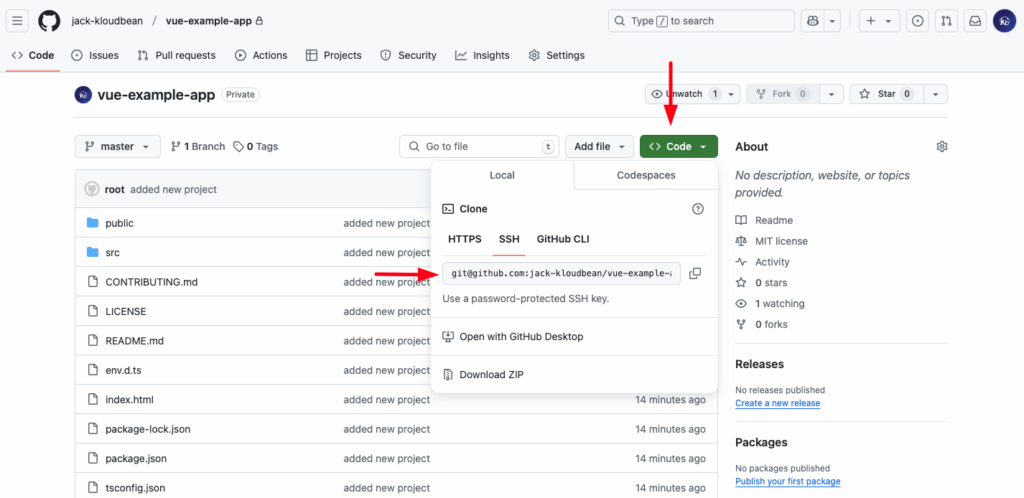
Create a Git repository for your project. Push your Lovable-generated code to this repository. In your Kloudbean Vue.js application dashboard, navigate to “Deploy Code.”
For private repositories, generate SSH keys within Kloudbean and add them to your Git repository settings. Copy your repository URL and paste it into Kloudbean’s deployment interface. Select your deployment branch and click “Clone Now.”
Kloudbean automatically:
- Pulls your code from the repository
- Installs dependencies
- Builds your application
- Deploys to production
- Configures SSL certificates
- Sets up monitoring
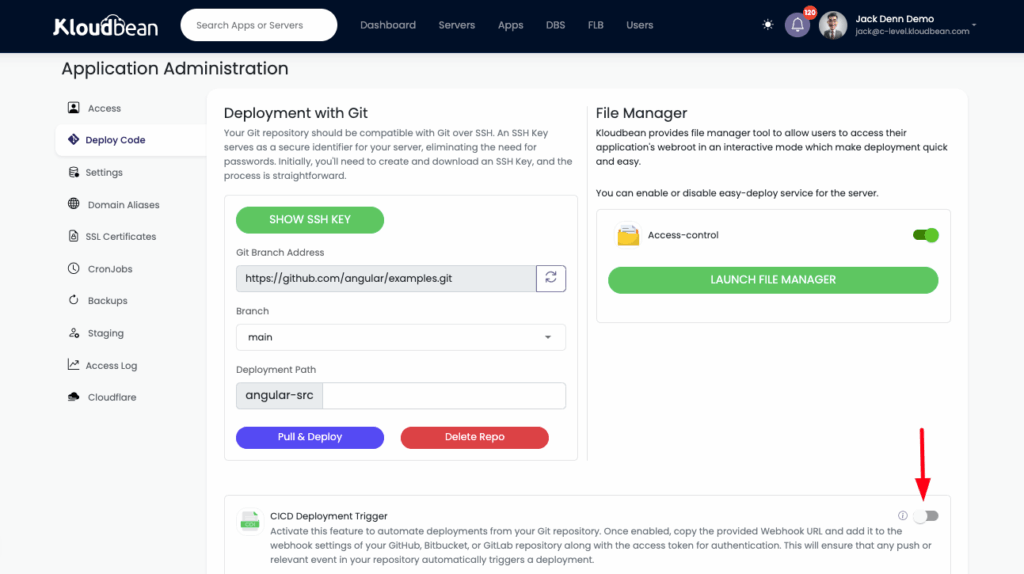
Set up continuous deployment by enabling webhooks between your Git repository and Kloudbean. Future code changes automatically deploy when you push updates.
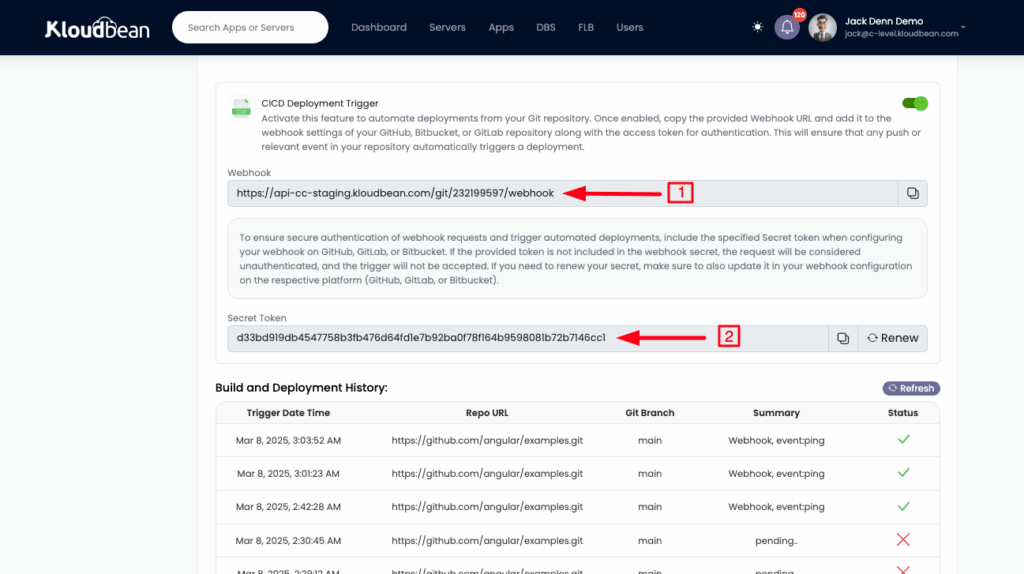
Testing Your Complete Setup
Verify everything works perfectly by testing all functionality:
Navigate through every page and confirm content loads from WordPress. Create new blog posts in WordPress admin and verify they appear immediately on your frontend. Test search functionality across all content types. Verify contact forms submit properly and you receive notifications.
Check responsive design on various devices and screen sizes. Test loading speeds using Google PageSpeed Insights – you should see dramatic improvements over traditional WordPress sites. Verify that dark/light mode toggle works correctly and user preferences persist.
The Advantages of This Complete Setup
This headless WordPress configuration provides capabilities that were impossible with traditional approaches:
Content Management Simplicity: You continue using WordPress exactly as you have for years. Create posts, upload media, manage users, install plugins – everything works identically, but your visitors experience dramatically better performance.
Instant Feature Development: Need a new landing page? Tell Lovable what you want and deploy the generated code in minutes. No more waiting weeks for custom development or struggling with page builder limitations.
Cost Effectiveness: One Kloudbean server runs multiple WordPress installations and frontends. No separate hosting bills, SSL charges, or service integration costs.
Future-Proof Architecture: As web technologies evolve, your modern foundation adapts easily. New AI tools integrate seamlessly. Performance improvements happen automatically.
Common Concerns and Solutions
Will this affect my SEO?
Headless WordPress actually improves SEO significantly. Faster loading times boost search rankings. Modern frontend frameworks handle meta tags, structured data, and crawling perfectly when properly implemented. Your Yoast SEO plugin data transfers automatically to your frontend.
What if I need to switch back?
Your WordPress installation remains completely intact. All content, users, and settings stay in WordPress. You can always return to traditional themes if needed, though you’ll lose the performance and design benefits.
Is this too technical for me?
The AI tools handle all technical complexity. You describe what you want in plain English. Kloudbean manages all server configuration. No coding knowledge required.
What about plugin compatibility?
Essential plugins work perfectly – SEO, security, backup, e-commerce. Some frontend-specific plugins become unnecessary since your custom frontend handles those features better.
How much does this really cost?
A complete setup on Kloudbean costs less than most traditional WordPress hosting plans. You eliminate separate frontend hosting, SSL certificates, CDN services, and premium theme purchases. Its starts from 8 USD.
Advanced Capabilities You Can Add
E-commerce Integration: Install WooCommerce on your WordPress backend. Lovable generates beautiful, custom shopping experiences that integrate seamlessly with WordPress product and order management.
Multi-language Support: Install WPML or similar plugins. Your frontend detects user language preferences and serves appropriate content automatically.
User Authentication: Implement registration, login, and profile management through WordPress user systems while providing modern, app-like authentication experiences.
Real-time Features: Add live chat, real-time notifications, or collaborative features that update instantly across all users.
Progressive Web App: Transform your site into an installable mobile app with offline capabilities and push notifications.
Maintenance and Long-term Management
WordPress Updates: Handle WordPress maintenance through the familiar admin interface. Your frontend continues running independently while you maintain your content management system.
Content Updates: Your content team continues using WordPress exactly as before. New posts, page updates, and media uploads appear on your live site automatically.
Design Changes: When you want new features or design updates, generate new code with Lovable and deploy through Kloudbean’s Git integration. Changes go live immediately.
Performance Monitoring: Kloudbean provides built-in monitoring for uptime, performance, and user experience. Receive alerts for any issues and maintain optimal performance automatically.
Support: Unlike traditional hosting where issues get passed between different technical teams, Kloudbean support understands your complete setup and can resolve problems quickly.
Why This Approach Wins in 2025
The combination of headless WordPress, AI-generated frontends, and unified hosting platforms like Kloudbean solves fundamental problems that have plagued web development for years.
Traditional WordPress development forces compromises. Performance versus functionality. Design flexibility versus ease of use. Cost versus capability.
This modern approach eliminates those compromises. You get enterprise-level performance at small business costs. Complete design freedom with content management simplicity. Cutting-edge technology without technical complexity.
Your competitors using traditional WordPress approaches can’t match your site speed, design flexibility, or development efficiency. You’re building with tomorrow’s tools while they’re stuck with yesterday’s limitations.
The web development industry is moving toward this architecture. Companies like Netflix, Airbnb, and countless others use similar approaches for their high-performance websites. Now these same capabilities are accessible to everyone through AI tools and platforms like Kloudbean.
Getting Started Today
You don’t need to wait or prepare extensively. Start with a simple project – perhaps a personal blog or small business site. The learning curve is minimal because AI handles the technical complexity.
Create your Kloudbean account and install WordPress. Use Lovable to generate your frontend. Follow the integration process I’ve outlined. You’ll have a professional, high-performance website running within days, not months.
The future of web development is here. WordPress for content management, AI for frontend generation, unified hosting for simplicity. This combination creates websites that perform better, cost less, and provide unlimited creative possibilities.
Your current WordPress approach served you well in the past. But user expectations have evolved. Performance standards have increased. Competition has intensified.
The tools exist today to build something dramatically better. The only question is when you’ll make the switch to join the headless WordPress revolution.
